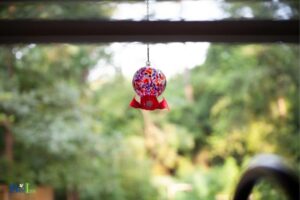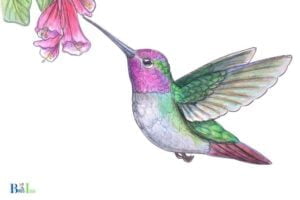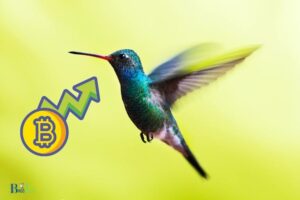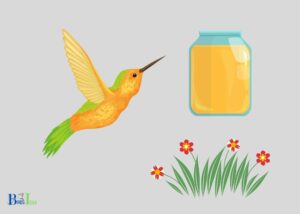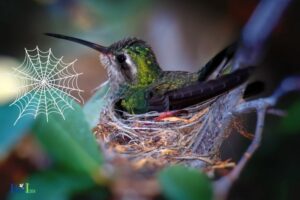How to Make Hummingbird Nectar Audubon? 7 Steps!
To make hummingbird nectar following the Audubon guidelines, you will need to mix a 1:4 ratio of white granulated sugar to water, boil the mixture for 2 minutes, let it cool, and then fill your feeder.
Hummingbird nectar, also known as sugar water, mimics the natural nectar found in flowers that hummingbirds feed on.
The Audubon Society’s recipe ensures that the nectar provides the proper nutritional balance for hummingbirds while being easy to prepare at home.
When preparing hummingbird nectar, it’s crucial to maintain the 1:4 sugar-to-water ratio as recommended by the Audubon Society.
This ratio ensures that hummingbirds receive the necessary energy to sustain their high metabolism without causing potential health issues.
Regularly clean and refill your feeder, especially during hot weather, to prevent mold and spoilage. Additionally, storing any unused nectar in the refrigerator can help extend its freshness.
7 Steps to Make Hummingbird Nectar Audubon
| Step | Instructions |
|---|---|
| 1 | Boil water in a pot or kettle. |
| 2 | Measure out 1 part sugar and 4 parts water. |
| 3 | Slowly add sugar to boiling water, stirring continuously until completely dissolved. |
| 4 | Remove from heat and let the mixture cool down to room temperature. |
| 5 | Fill the hummingbird feeder with the cooled nectar mixture. |
| 6 | Hang the feeder in a shaded spot, away from direct sunlight to prevent rapid spoilage. |
| 7 | Clean and refill the feeder every 2-3 days (more frequently in hot weather) to maintain freshness and cleanliness. |
Key Takeaway
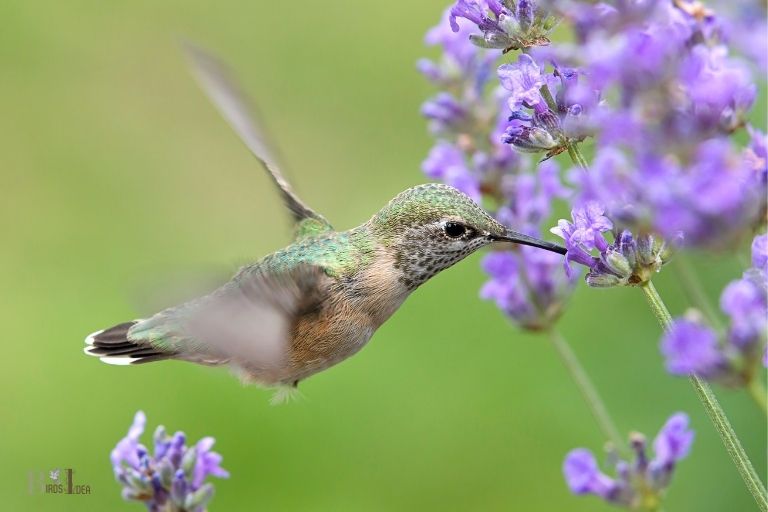
Five Facts About Making Hummingbird Nectar Audubon
What Is Hummingbird Nectar?
Definition Of Hummingbird Nectar
Hummingbird nectar is a sweet, liquid food that attracts hummingbirds to your garden or outdoor space. This nectar is usually made from a combination of sugar and water.
It is important to avoid adding any artificial sweeteners, honey, or molasses to the mix as hummingbirds cannot digest it.
- The standard recipe for hummingbird nectar is one part granulated white sugar to four parts water.
- The nectar should be boiled and allowed to cool before being poured into a feeder.
- Store-bought nectar is available, but it is not recommended as it often contains preservatives and dyes that are harmful to hummingbirds.
Why Is It Important To Use The Right Type Of Nectar?
Using the right type of nectar is important because hummingbirds are selective feeders. They have specific dietary requirements that need to be met for their health and wellbeing.
- Certain foods like honey and molasses can be harmful and cause fungal growth, leading to deadly infections.
- Artificial sweeteners are also harmful as hummingbirds cannot digest them.
- Using proper nectar in your hummingbird feeders will help ensure that they remain healthy and vibrant.
Understanding Hummingbird Feeding Habits
Hummingbirds have a high metabolism and require a substantial amount of nectar to maintain their energy levels.
Here are a few important pointers when it comes to understanding their feeding habits.
- Hummingbirds feed frequently, visiting the feeder multiple times a day to eat.
- They prefer fresh, clean nectar and may avoid feeders that are dirty or contain old nectar.
- It is important to keep feeders clean and filled to ensure they have a continuous supply of food.
Overall, providing the right type of nectar and maintaining clean feeders will attract hummingbirds to your garden and provide them with the nutrition they need to thrive.
Ingredients For Making Hummingbird Nectar
Hummingbirds are fascinating and beautiful creatures that are incredibly active and agile. They need to consume a considerable amount of nectar to maintain their high-energy lifestyle.
If you’re interested in attracting these birds to your backyard, it’s essential to understand how to make hummingbird nectar audubon. In this post, we will detail the ingredients you will need for making hummingbird nectar.
White Granulated Sugar
One of the most critical ingredients in making hummingbird nectar audubon is white granulated sugar. You will need one part sugar to four parts water.
When using the sugar, avoid using brown sugar, honey, or molasses. These sweeteners have excess iron, which could harm the birds.
Here are some essential points to remember when using white granulated sugar to make hummingbird nectar:
- Use only white granulated sugar: It is essential to use the right kind of sugar as using any other sugar types could harm the birds.
- Add only one-part sugar to four parts water: Using more sugar could increase the likelihood of the birds developing liver damage.
- Do not use any artificial sweeteners or honey: Artificial sweeteners such as splenda or equal are also harmful to birds, and honey has too much indigestible sugar.
Water
The next essential ingredient when making hummingbird nectar is water. Use only fresh, clean water that does not have any contaminants or impurities. Alternatively, you may also use distilled water.
Here are some critical points to remember when using water to make hummingbird nectar:
- Use only clean and fresh water: Contaminated or impure water could lead to birds developing bacterial infections and diseases.
- Avoid using tap water: Use only distilled water if you have any reservations about your tap water quality.
Choosing The Right Water
Choosing the right water for hummingbird nectar audubon is essential as it will help avoid harm to the birds.
Here are some critical points to remember when choosing the right water for your hummingbird nectar:
- Steer clear of using stagnant water: Stagnant water may have microorganisms and bacteria that could harm the birds.
- Use fresh and clean water: Using water that contains contaminants or pollutants will not only harm the birds but could also attract other birds and animals.
- Do not use chemically-treated water: Using chemically treated water is harmful to the birds and could lead to injuries or diseases.
Avoiding Artificial Sweeteners
Bird enthusiasts need to know that artificial sweeteners are not a healthy substitute for regular sugar when making hummingbird nectar. It’s essential to use white granulated sugar only for the birds’ health and well-being.
Here are some critical points to remember when avoiding artificial sweeteners:
- Avoid using sucralose or aspartame: These sweeteners are harmful to hummingbirds and could lead to malformations.
- Artificial sweeteners could result in the hummingbirds developing liver damage: The bird’s liver is ill-equipped to handle metabolizing these sweeteners’ components.
- Artificial sweeteners could lead to dehydration: Using these sweeteners results in the bird drinking less liquid, which could lead to dehydration.
Understanding how to make hummingbird nectar audubon is crucial to these beautiful and fascinating creatures’ health and well-being.
You must use white granulated sugar and follow the correct measurements to avoid any harm. Remember to use clean water to avoid diseases and refrain from using artificial sweeteners.
Attracting these birds to your backyard is an entertaining and joyful experience, and providing them with the right nectar will help them thrive.
How To Make Hummingbird Nectar Audubon
Hummingbirds are beautiful and tiny birds that are native to the americas. They are known for their ability to hover mid-air and flap their wings at astonishingly high speeds.
These little birds have a high metabolism, and they need to consume nectar frequently to maintain their energy levels.
To attract hummingbirds to your garden, it’s essential to provide them with the right food. In this section, we will discuss how to make hummingbird nectar audubon.
Choosing The Right Ratio Of Sugar To Water
Making hummingbird nectar is effortless and inexpensive.
Here are some crucial points to keep in mind while making nectar:
- The standard ratio of sugar to water should be 1: 4.
- Use granulated white sugar. Avoid using honey, brown sugar, or artificial sweeteners, as they can be harmful to hummingbirds.
- Use only hot water to prepare the nectar as it helps the sugar dissolve.
Boiling The Mixture
Boiling the nectar mixture is essential to eliminate bacteria that may be present in the sugar or water.
Follow these steps to boil the nectar:
- Stir the sugar and water mixture until the sugar dissolves.
- Bring the mixture to a rolling boil.
- Remove the mixture from the heat source and let it cool.
Cooling The Nectar
It’s crucial to cool the nectar mixture before pouring it into feeders. Never add hot nectar to hummingbird feeders as it can burn their tongues and beaks.
Follow these steps to cool the nectar mixture:
- Allow the nectar mixture to cool completely.
- Once cooled, pour the nectar into the feeder.
Storing The Nectar
It is not recommended to store hummingbird nectar for more than a week.
Here are some tips for storing nectar:
- Store the remaining nectar in a clean, airtight container.
- Keep the container in a cool and shaded place.
- Do not refrigerate the nectar.
Tips For Maintaining Cleanliness Of Feeder And Nectar
Maintaining the cleanliness of the feeder and nectar is essential to prevent the growth of harmful bacteria.
Here are some tips to consider:
- Clean your hummingbird feeders every 3-4 days with hot water and soap.
- Rinse the feeder thoroughly and let it air dry before refilling.
- Avoid using any harsh chemicals or bleach to clean the feeder.
- If you notice mold or fungus growth, clean the feeder with a vinegar solution.
- Dispose of any remaining nectar after three days, and clean the feeder thoroughly.
Making hummingbird nectar is simple and easy. Follow these steps to ensure that your hummingbird feeder is always full of fresh and nutritious nectar.
By providing the right food, you can attract these beautiful birds to your garden and enjoy watching them for hours.
Common Hummingbird Nectar Mistakes And How To Avoid Them
How to make hummingbird nectar audubon: common hummingbird nectar mistakes and how to avoid them
Hummingbirds are fascinating creatures that require nectar to survive. Making nectar at home for your backyard friends is an excellent way to attract these delightful birds. However, there are many common mistakes to avoid when making hummingbird nectar.
Here are the key points to consider when making hummingbird nectar at home.
Using Red Food Coloring
Adding red food coloring to hummingbird nectar is a common mistake. Although it makes the nectar appear more appetizing to the birds, it is unnecessary and potentially harmful.
Here’s why:
- Red food coloring contains additives that may not be safe for hummingbirds.
- Some hummingbirds have an allergic reaction to red food color, resulting in swollen tongues and beaks.
- Natural nectar from flowers does not contain red food coloring, so it is unnecessary to add it.
Using Brown Sugar Or Honey
Using brown sugar or honey to make hummingbird nectar is another mistake to avoid. Although sugar is an essential ingredient, brown sugar and honey are not suitable substitutes for white granulated sugar.
Here’s why:
- The added minerals in brown sugar and honey make the nectar less healthy for hummingbirds.
- Honey can cause a fungal infection called “black tongue” in hummingbirds, which can be fatal.
Changing The Ratio Of Sugar To Water
Some people believe that increasing the sugar concentration in the nectar will make it more attractive to the birds. However, changing the ratio of sugar to water is another mistake to avoid because it can have detrimental effects.
Here’s why:
- A higher sugar concentration can cause dehydration in hummingbirds, leading to serious health problems or even death.
- Natural nectar from flowers has a sugar concentration of around 20-25%, so a 1: 4 sugar to water ratio is ideal.
Not Cleaning The Feeder Regularly
Failing to clean the hummingbird feeder regularly is a common mistake. Dirty feeders can cause harmful mold and fungus to grow, which can be harmful to birds.
Here’s why:
- Dirty feeders can spread disease and infections to hummingbirds.
- Moldy nectar can cause fungal infections in hummingbirds, leading to serious health problems or even death.
Leaving The Feeder Out For Too Long
Leaving the hummingbird feeder out for too long is another mistake to avoid. Old nectar can become contaminated, and fresh nectar turns into a breeding ground for bacteria and fungi.
Here’s why:
- Over time, nectar can ferment and produce harmful bacteria that can make hummingbirds sick or worse.
- Leaving the feeder out too long can attract other insects, such as ants, bees, and wasps, which can be harmful to hummingbirds.
Making hummingbird nectar at home is easy and fun. However, making common mistakes can be harmful to these delightful birds.
By avoiding the mistakes outlined above, you can provide healthy and safe nectar for your backyard friends.
Remember to clean the feeder regularly, use white granulated sugar, and avoid red food coloring, brown sugar, and honey.
Enjoy the sight of your visiting hummingbirds!
Attracting Hummingbirds To Your Yard: Tips And Tricks
Hummingbirds are fascinating birds and the perfect way to invite them into your yard is to set up hummingbird feeders.
Here are some tips and tricks to attract hummingbirds to your yard:
Choosing The Right Feeder
Choosing the right feeder is critical as it can impact hummingbird feeding behavior.
Here are some things to consider before purchasing a feeder:
- Make sure the feeder is easy to clean and refill.
- Opt for a feeder with bee guards to prevent bees from hogging the nectar.
- Choose a feeder with red parts because hummingbirds are more attracted to red.
Choosing The Right Location
Location is a key factor when it comes to attracting hummingbirds.
Here are some tips to bear in mind:
- Place the feeder at least 10 feet away from shrubs and trees to avoid ambush by predators.
- Locate the feeder where hummingbirds can see it from a distance easily.
- Position the feeder away from direct sunlight to prevent the nectar from fermenting quickly.
Timing Of Feeding Hummingbirds
Timing is all about synchronizing the feeding times and spending some quality time watching these lovable creatures.
Here are some tips to remember:
- The best times to feed hummingbirds are early in the morning or late in the evening.
- Ensure that your feeder is fresh and full of sweet nectar.
- Refrain from adding food coloring to the nectar.
Providing Other Sources Of Food And Shelter
Adding other sources of food and shelter to your yard can make hummers more comfortable to visit.
Here are some things to keep in mind:
- Plant flowers that produce nectar, such as honeysuckle and trumpet vine.
- Consider getting a hummingbird swing where these birds can perch and rest.
- Hang some nesting material, such as spider webs or cotton, to promote hummingbird nesting in your yard.
How To Watch And Enjoy Hummingbirds
Watching hummingbirds is a rewarding experience, and below are some pointers to make the most of it:
- Refrain from sudden movements or loud noises that can scare hummingbirds.
- Use binoculars or a camera to see hummingbirds up close.
- Sit in a comfortable chair with a refreshing drink and enjoy the hummingbirds’ sights and sounds.
By following these tips and tricks, you can create a hummingbird haven in your backyard, and enjoy the beauty of these fascinating birds all year round.
FAQ On Make Hummingbird Nectar
What Is Hummingbird Nectar Made Of?
How Do I Make Hummingbird Nectar?
Can I Use Honey Instead Of Sugar To Make Hummingbird Nectar?
How Often Should I Change Hummingbird Nectar?
How Do I Clean My Hummingbird Feeder?
Conclusion
After reading this article, you now have all the information that you need to make hummingbird nectar audubon style. It is incredibly easy to make, requires only a few ingredients, and is much cost-effective than purchasing pre-made nectar.
The key is to remember to always use pure white granulated sugar instead of honey or artificial sweeteners. Keep in mind that the mixture should be changed every 3-5 days to prevent fermentation and mold growth.
You can also use red food coloring to attract hummingbirds, but it is not necessary. By following these simple steps, you can enjoy watching these beautiful creatures visit your feeder all season long. Your backyard will surely become a hummingbird haven in no time!

